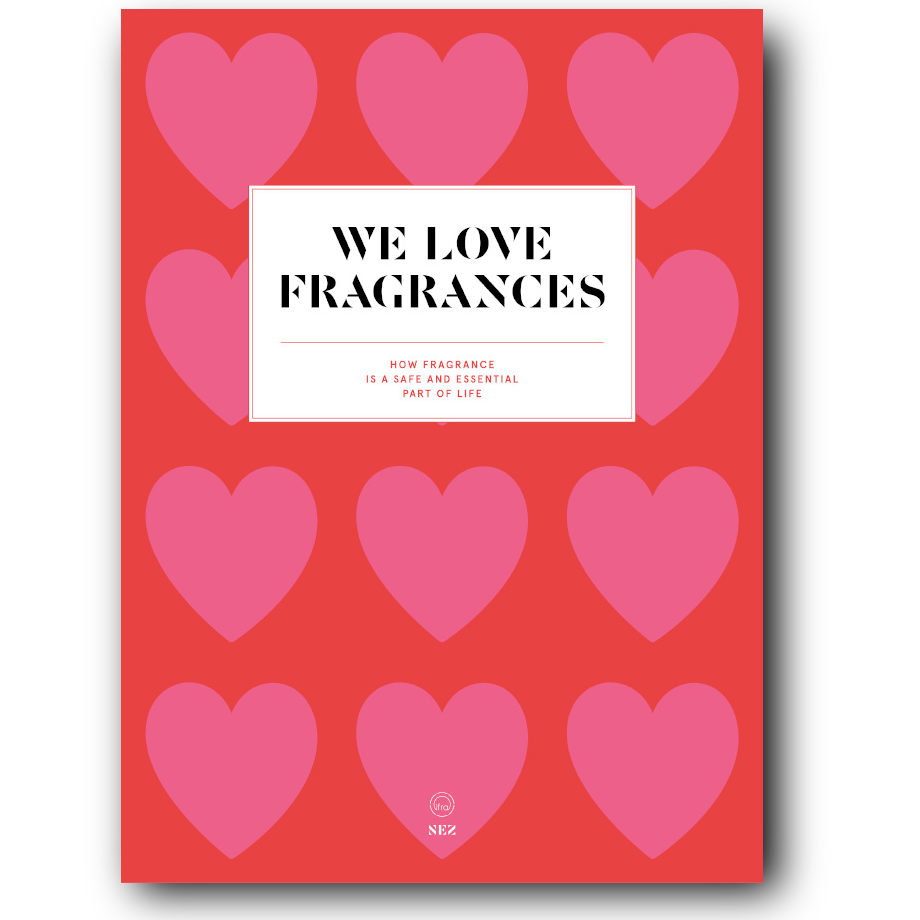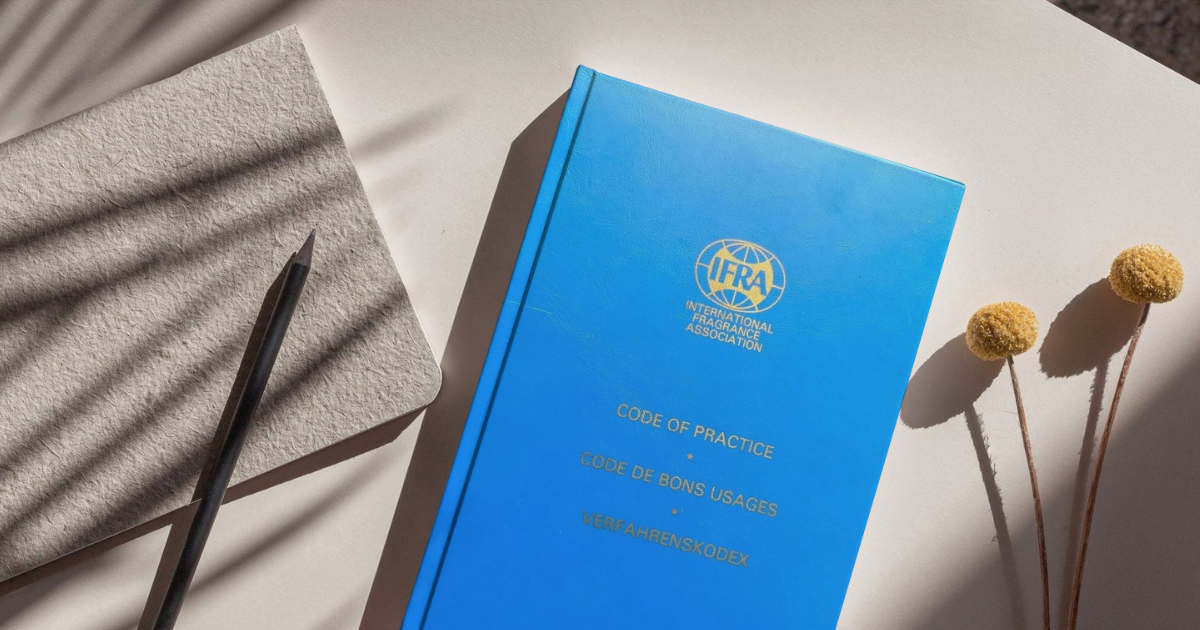Cette publication est également disponible en :
Français
In 1973, IFRA was founded in response to the need to harmonize practices and products in the fragrance industry to better regulate it, with a focus on human and environmental safety. An organization created by fragrance companies to ensure the safety of products for consumers and to defend the creativity of perfumers.
This article has been taken from our book We Love Fragrances (see below)
In the early 1960s, a number of actors wishing to maintain the drive to structure and rationalize the sector suggested that it needed to self-regulate to protect people and the environment while continuing to exist and filling the world with the magic of fragrance. Even if production quantities remained low compared to those in other industries, its growing workforce, output and export of its products worldwide called for increasingly specific mechanisms. These factors inspired Arnold Louis van Ameringen, IFF chairman at the time, to send a letter in 1965 to the heads of the main rival composition houses, proposing the idea of creating an independent body to assess the safety of perfumery ingredients. The perfumery companies already carried out their own research, but it was neither systematic nor exhaustive. The Research Institute for Fragrance Materials (RIFM) was created in 1966 to fill this gap, producing the scientific data that had been missing until then. But generating the data alone was not enough: The data needed to be made actionable and turned into concrete guidelines for perfumers to refer to while all the information produced by the composition companies needed to be aggregated.
IFRA as the regulatory authority for self-regulation
Guy Waldvogel, then CEO of Givaudan, and his colleagues in the industry built on this same goal of safety and went one step further when they founded the International Fragrance Association (IFRA) in 1973, together with the existing National Fragrance Associations. Since the data generated by RIFM obliged nobody to act on it, a new body was needed to self-regulate the safe use of fragrance ingredients. The principle was fairly straightforward: since the association was created in response to the needs of perfumery actors to manage risks, it was up to them to finance it. It should develop a code of practice for the industry worldwide and set standards for the maximum dose of certain fragrance ingredients that could be added to certain consumer products. There was no specific legislation governing the small quantities of fragrances used, which is why a self-regulation approach would demonstrate responsible product stewardship.
Several national associations joined forces as part of this initiative: United States, Japan, Switzerland, France, Germany, Italy, the Netherlands, Spain and the United Kingdom. To guarantee its independence, IFRA is a not-for-profit organization with scientific aims, separate from RIFM. IFRA works in a way that
ensures optimum transparency: Any problems identified with a raw material result in the official publication of an IFRA Standard to promote the safe use of the raw material in question.
IFRA plays a crucial role in providing comprehensive insights into the fragrance industry by maintaining a detailed record of its ingredients. To achieve this, all IFRA members are invited to participate in the Volume of Use Survey, a completely anonymous and confidential process.
This survey is conducted roughly every five years and mandates the disclosure of ingredients used in fragrance mixtures worldwide. The collected data is then compiled by IFRA and results in the publication of the valuable Transparency List.
The latest update of the Transparency List in 2022 featured a staggering 3,224 fragrance ingredients utilized for odor or malodor coverage, along with 395 functional ingredients that may be found in perfume mixtures. This list also serves as the vital foundation to establish the scope of ingredients for the activities of RIFM, through rigorous scientific assessments.
IFRA members agree to a Code of Practice which includes not only compliance with all applicable legislation but also respect for the IFRA Standards – the rules detailing the conditions for using ingredients to guarantee they are safe for consumers and the environment. All of these efforts align with IFRA’s vision that “fragrance is a safe and essential part of life,” which is supported by its mission to “promote the safe use of fragrance for everyone’s enjoyment.” These principles are upheld through three core values: “Science is our foundation”; “We advocate with integrity”; and “We are committed to collaboration.”
These values play a pivotal role in achieving IFRA’s four primary strategic objectives: first and foremost, fostering self-regulation and advocacy; secondly, promoting global collaboration; thirdly, enhancing consumer knowledge and enjoyment; and last but not least, prioritizing sustainability, which has become a central area of concern for both IFRA and the fragrance industry at large.
IFRA as a global umbrella trade association
However, since the mid-1990s in Europe and the 2000s in other geographies, regulations imposed by the governments of various countries have become increasingly wide-ranging and drastic.
A development that led IFRA to open an office in 1996 in Brussels, the city that houses the European Commission, European Parliament and the Council of the European Union. IFRA took on an additional role: Together with its National Association Members, IFRA is globally advocating for the industry to policymakers to make sure the sector’s voice is heard when drawing up new regulations. IFRA shares its expertise in the perfumery field, including on regulatory and scientific aspects, to confirm that any future laws will reflect the sector’s realities.
The EU has highly sophisticated chemicals management legislation in place and has the most active of all regulatory schemes in the world. We have observed regulatory spillover of European legislation into other geographies, thereby causing a regulatory ripple.
In Asia-Pacific (APAC), besides Japan where regulation was already in place, countries introduced their own chemicals management and downstream legis- lations, notably Korea REACH or new cosmetics legislation in China. These emerging regulatory developments in the APAC region led IFRA to open an office in Singapore in 2017 and strengthen its collaboration with its National Association Members in Australia and New Zealand, China, Indonesia, Japan, the Republic of Korea and Singapore, as well as working regionally with partner associations like the ASEAN Cosmetics Association (ACA), among others.
In Latin America, including the Mercosur region, countries are also introducing emerging chemicals management legislation requiring the active engagement of IFRA.
This prompted IFRA to open an office in São Paulo in 2018 and bolster its collaboration with its National Association Members in Argentina, Brazil, Chile, Colombia and Mexico, as well as with regional partner associations like CASIC, the horizontal Latin American cosmetics, toiletry and perfumery association.
IFRA additionally opened an office in Delhi, India, in 2019, just before the COVID-19 pandemic. The reason for a more local presence is that India is a key sourcing hub of natural and synthetic ingredients for fragrances globally. In partnership with the Federation of Indian Chambers of Commerce & Industry
(FICCI), IFRA created a fragrance committee within FICCI. Together with its network of 23 National Association Members, IFRA seeks to be a model of global collaboration by fostering engagement, dialogue, cooperation and partnerships.
IFRA as the facilitator for the industry’s Sustainability Charter and collective voluntary sustainability initiatives
Another area where IFRA acts is in communicating information between the different stakeholders in the fragrance value chain. Its role : IFRA proposes a common framework for joint efforts for the fragrance and flavor industry with the IFRA-IOFI Sustainability.
Charter and has created the IFRA Green chemistry Compass, which offers a universal tool for ingredient sustainability assessment, accessible to companies of all sizes.
IFRA provides a wide range of opportunities, tools and events for sharing information with members and the public, from specific regional events attended by members and stakeholders to discuss industry issues to the Global Fragrance Summit, IFRA’s annual marquee event, bringing together representatives from
the entire fragrance value chain since 2017 to explore the sector’s trends, challenges and opportunities, and including conferences, webinars and newsletters.
IFRA’s history has also been marked byseveral partnerships and collaborations that have seen it evolving over time. For instance, in 2017, it signed an agreement with the Union for Ethical BioTrade UEBT) to collaborate on promoting ethical and sustainable commercial practices in the industry as well as to identify and minimize any supply chain risks, in particular on the responsible sourcing of natural raw materials.
One of the first steps in encouraging the industry to make a collective commitment to practices that are more sustainable was to draw up an inventory of all the positive actions already taken in this domain. IFRA and IOFI, which had been historical partners, joined forces and spent four years working with members and external experts to develop a Sustainability Charter and identified the specific commitments embedded in a sustainability roadmap for the flavor and fragrance industries. The first IFRA-IOFI Sustainability Report was published in 2021; the second IFRA-IOFI Sustainability Report was published in June 2023. The reports can be used to track progress made by the sector in terms of sustainability over the coming years. The IFRA- IOFI Sustainability Charter, now signed by 138 companies, structures the collective commitment of the fragrance and flavor industry into five key areas: respon-
sible sourcing; reducing our environmental footprint; employee well-being; product safety; and transparency.
This text has been first publish in the book We Love Fragrances
The main dates of IFRA
1969: Founding of the International Organization of the Flavor Industry (IOFI)
1973: Founding of the International Fragrance Association (IFRA)
1974: Publication of the first IFRA Code of Practice and the first IFRA Standards (36 ingredients compared to more than 200 today)
1996: Opening of the IFRA
2001: Three-way split between regular members, national associations and supporting members
2006: Launch of the first version of the Quantitative Risk Assessment (QRA), a method for assessing human health risks linked to the use of fragrances and flavors
2012: Creation of the International Dialogue for the Evaluation of Allergens (IDEA)
2016: Launch of the IFRA-IOFI Sustainability Initiative, which aims to raise the bar across the fragrance and flavor industries, taking a life-cycle approach
2019: Opening of the IFRA office in Delhi, India Implementation of QRA2 in the 49th Amendment to the IFRA Standards Publication of “The Value of Fragrance” report
2022: Publication of Business Analysis of the Impacts of the Chemicals Strategy for Sustainability

We Love Fragrances, Nez, 160 pages, 2023
The world of fragrance, in all its infinite variety, is an essential part of our lives. Its many perspectives – cultural, economic, social and emotional, as well as agricultural, industrial and technological – are explored in this book, showing just how much fragrance is an element that links us together. To perpetuate this field, the International Fragrance Association (IFRA) plays a role in the safety and sustainability of fragranced products.
We Love Fragrances brings together numerous testimonials and gives voice to all players in the value chain, from growers, suppliers of natural and synthetic raw materials, creators and producers to researchers, engineers and chemists… A book to discover and rediscover fragrance in all its different facets and understand its present and future challenges.
—








Comments